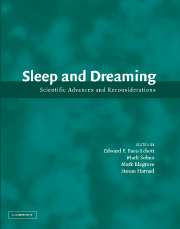Book contents
- Frontmatter
- Contents
- Preface
- Introduction
- 1 Dreaming and the brain: Toward a cognitive neuroscience of conscious states
- 2 Dreaming and REM sleep are controlled by different brain mechanisms
- 3 A review of mentation in REM and NREM sleep: “Covert” REM sleep as a possible reconciliation of two opposing models
- 4 The case against memory consolidation in REM sleep
- 5 The reinterpretation of dreams: An evolutionary hypothesis of the function of dreaming
- Open Peer Commentary and Authors' Responses
- References
- Postscript: Recent findings on the neurobiology of sleep and dreaming
- Index
5 - The reinterpretation of dreams: An evolutionary hypothesis of the function of dreaming
Published online by Cambridge University Press: 11 January 2010
- Frontmatter
- Contents
- Preface
- Introduction
- 1 Dreaming and the brain: Toward a cognitive neuroscience of conscious states
- 2 Dreaming and REM sleep are controlled by different brain mechanisms
- 3 A review of mentation in REM and NREM sleep: “Covert” REM sleep as a possible reconciliation of two opposing models
- 4 The case against memory consolidation in REM sleep
- 5 The reinterpretation of dreams: An evolutionary hypothesis of the function of dreaming
- Open Peer Commentary and Authors' Responses
- References
- Postscript: Recent findings on the neurobiology of sleep and dreaming
- Index
Summary
Abstract: Several theories claim that dreaming is a random by-product of REM sleep physiology and that it does not serve any natural function. Phenomenal dream content, however, is not as disorganized as such views imply. The form and content of dreams is not random but organized and selective: during dreaming, the brain constructs a complex model of the world in which certain types of elements, when compared to waking life, are underrepresented whereas others are over represented. Furthermore, dream content is consistently and powerfully modulated by certain types of waking experiences. On the basis of this evidence, I put forward the hypothesis that the biological function of dreaming is to simulate threatening events, and to rehearse threat perception and threat avoidance. To evaluate this hypothesis, we need to consider the original evolutionary context of dreaming and the possible traces it has left in the dream content of the present human population. In the ancestral environment human life was short and full of threats. Any behavioral advantage in dealing with highly dangerous events would have increased the probability of reproductive success. A dream-production mechanism that tends to select threatening waking events and simulate them over and over again in various combinations would have been valuable for the development and maintenance of threat-avoidance skills. Empirical evidence from normative dream content, children's dreams, recurrent dreams, nightmares, post traumatic dreams, and the dreams of hunter-gatherers indicates that our dream-production mechanisms are in fact specialized in the simulation of threatening events, and thus provides support to the threat simulation hypothesis of the function of dreaming.
Keywords: dream content; dream function; evolution of consciousness; evolutionary psychology; fear; implicit learning; nightmares; rehearsal; REM; sleep; threat perception …
- Type
- Chapter
- Information
- Sleep and DreamingScientific Advances and Reconsiderations, pp. 85 - 110Publisher: Cambridge University PressPrint publication year: 2003
- 7
- Cited by



